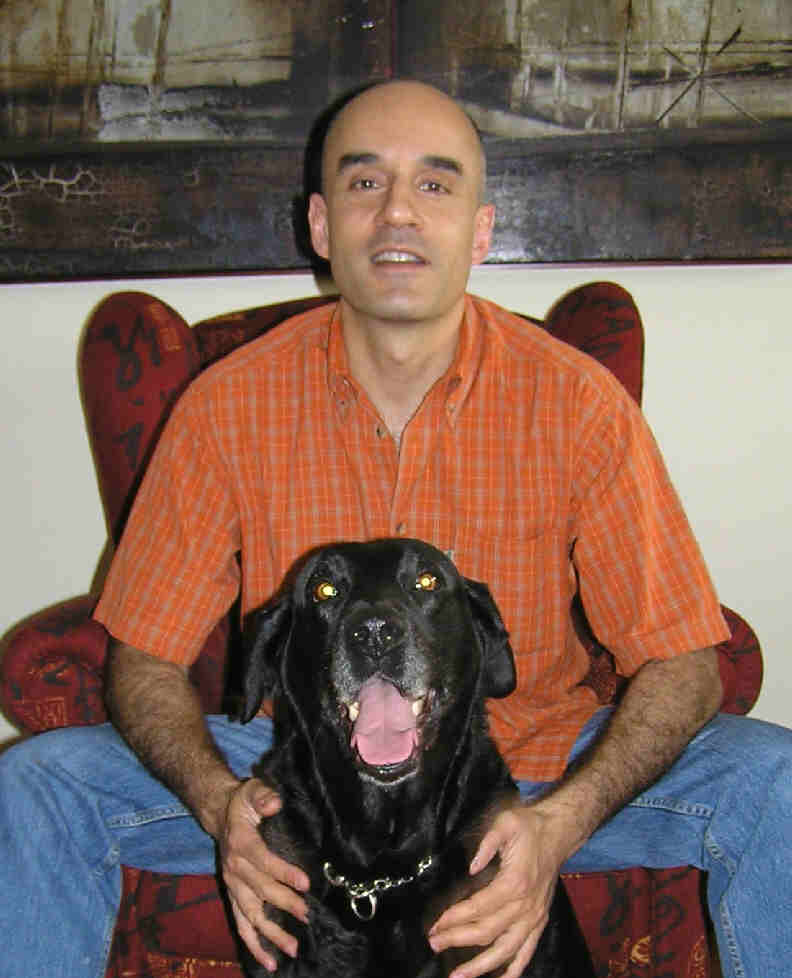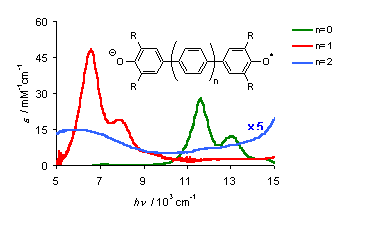

João Paulo Cabral Telo
Professor Auxiliar
|
Departamento de Engenharia Química Instituto Superior Técnico Universidade Técnica de Lisboa Av. Rovisco Pais P - 1049-001 Lisboa Portugal |
|
|
telefone: (+351) 21 841 7879 fax: (+351) 21 8417122 email: jptelo@ist.utl.pt |
|
Formação Académica
Interesses científicos
Organic Mixed-Valence
radicals
Electron Paramagnetic
Resonance (EPR) and Optical VIS/NIR
spectroscopies
are used to study Organic Mixed-Valence compounds (radical-anions) of the
general formula M-B-M-, that have symmetrical charge-bearing units
separated by a bridge. These are the simplest electron-transfer system known and
their study enables to test current electron-transfer theories, like the
well-known Marcus-Hush
theory.
The
studies have been centred mainly on Dinitro Arene radical-anions. Enormous
versatility, achievable synthesis and reasonable stability (under anoxic
conditions) make this class of organic radicals an interesting subject area on
Organic Mixed-Valence chemistry. Some examples of dinitro radical anions studied
are shown below.

The
transition from Localised (the charge is instantaneously localised in one nitro
group) to Delocalised (the charge is delocalised evenly over the two nitro
groups) has been of special interest to us. Radical anions like
pseudopara-dinitro[2.2.2]paracyclophane, 4,4'-dinitrostilbene and
4,4'-dinitrotolane (optical spectra in the picture) are so close to the
Localised/Delocalised borderline that changing solvent makes them change class.

Other
examples include extended quinone radial anions. They all show optical spectra
typical of delocalised mixed valence compounds, but the long quaterphenoquinone
(n=2) radical anion shows the wide and featureless optical band typical of a
localised compound.

Redox
Chemistry of Oxidants and Antioxidants
EPR spectroscopy, HPLC analysis and other techniques have been used to study
molecules that may induce oxidative stress and the redox chemistry of
antioxidant compounds that may prevent oxidative stress.
Examples of the former are the elucidation of responses to oxidative stress in
yeast upon exposure to the herbicide 2,4-dichlorophenoxyacetic acid [2,4-D].
Studies on the antioxidant effects of polyphenols like resveratrol (3,5,4'-trihydroxystilbene),
present in red wine,
e-viniferin
and of other non-natural hydroxystilbenes, used as model compounds, enabled us
to understand the effects of these powerful antioxidants on the prevention of
oxidative stress.

We have also studied the potential antioxidant effect of several xanthines and investigated the mechanism of their reaction with reactive oxygen species. Uric acid is a well known antioxidant and methyluric acids are good antioxidants as long as they are unsubstituted at N7, since these compounds react with radicals by H-abstraction at N(7)-H. Most methylxantines present in the human diet (like caffeine, theophyline and theobromine) react with oxidant species, but again the antioxidant effect in enhanced for theophyline as compared with caffeine or theobromine, since this compound, found in tea, has a H at the N7 position, and not a methyl group.

Serviços Académicos
Tem lecionado as cadeiras de Laboratórios de Química Orgânica (I
e II) e Química Orgânica I e II da licenciatura em Química, Engª Química
e Engª Biológica.
Nos últimos anos tem regido a cadeira de Química
Orgânica na licenciatra de Engª de Materiais, Engª Biomédica e Engª do
Ambiente. É coordenador do laboratório de química orgânica.
Publicações Representativas
Telo, J.P., Shohoji, M.C.B.L., Herold, B.J., Grampp, G.. Intramolecular Electron Exchange in the 2,7-dinitronaphtalene Radical Anion: Electron Paramagnetic Resonance and Kinetic Data; J. Chem. Soc., Faraday Trans, 88 (1), 47, 1992.
S. Steenken, J.P. Telo, H.M. Novais, L.P. Candeias, One-electron reduction potentials of pyrimidine bases, nucleosides and nucleotides in aqueous solution. Consequences for DNA redox chemistry, J. Am. Chem. Soc. 114 (12), 4701 (1992)
J.P. Telo, A.J.S.C. Vieira, Mechanism of free-radical oxidation of caffeine in aqueous solution, J. Chem. Soc. Perkin Trans. 2, 1755 (1997).
J.P. Telo, M.C.B.L. Shohoji, Radical-anions of dinitrophenols in aqueous solution: intramolecular electron exchange and acid-base equilibria, J. Chem. Soc. Perkin Trans. 2, 711 (1998).
J.P. Telo, G. Grampp, M.C.B.L. Shohoji, Solvent effects in the intramolecular electron exchange in the 1,4-dinitrobenzene radical-anion, Phys. Chem. Chem. Phys. 1, 99 (1999).
A.J.S.C. Vieira, J.P. Telo, R.M.B. Dias, Generation of hydroxyl radical by photolysis of Mercaptopyridine N-oxides: Application to redox chemistry of purines, in Methods in Enzymology 300, 194 (1999).
C.
Privat, J.P. Telo, V. Bernardes-Genisson, A. Vieira, J.P. Souchard, F. Nepveu, Antioxidant
properties of trans-e
-viniferin as
compared to stilbene derivatives in aqueous and non-aqueous media, J.
Agric. Food Chem. 50 (5), 1213
(2002).
H.M.
Novais, J.P. Telo, S. Steenken, Structure
of Radicals Derived from Hydroxypyrimidines in Aqueous Solution, J. Chem. Soc. Perkin
Trans. 2, 1412
(2002).
M.H. Kleinman, J.P. Telo, A.J.C.S. Vieira, C. Bohne, J.C Netto-Ferreira, Transient Spectroscopy for the Photochemistry of Ninhydrin, Photochem. Photobiol., 77 (1), 10 (2003).
J.P. Telo, Radicals derived from Uric Acid and its Methyl derivatives in Aqueous Solution: An EPR spectroscopy and theoretical study., Org. Biomol. Chem., 1, 588 (2003).
S.F. Nelsen, A.E. Konradsson, M.N. Weaver,
J.P. Telo, “Intervalence Near-IR Spectra of Delocalized Dinitroaromatic
Radical-Anions”, J. Am. Chem Soc.,
125 (41), 12493 (2003).
V. Farines, M.C. Monje, J.P. Telo, E.
Hnawia, M. Sauvain, F.
Nepveu; "Polyphenols as superoxide dismutase
modulators and ligands for estrogen receptors", Anal.
Chim Acta. 513 (1),
103-111(2004).
C.F. Correia, R.M. Borges dos Santos, S.G. Estácio, J.P. Telo, B.J.
Costa Cabral, J.A. Martinho Simões, "Reaction of para-Hydroxyl-substituted
Diphenylmethanes with tert-Butoxy
Radical", ChemPhysChem, 5
(8), 1217-1221 (2004).
M.C.
Teixeira, J.P. Telo, I. Sá-Correia; "The herbicide
2,4-dichlorophenoxyacetic acid induces the generation of free radicals and
associated oxidative stress responses in yeast", Biochem.
Biophys. Res. Comm., 324,
1101-1107 (2004).
(S.F.
Nelsen, M.N. Weaver, A.E. Konradsson, J.P. Telo, T. Clark, “Electron
transfer within 2,7-dinitronaphthalene Radical-Anion", J.
Am. Chem. Soc., 126 (47),
15431-15438 (2004).
S.F.
Nelsen, A. Konradsson, J.P. Telo, “Pseudo-para-Dinitro[2.2]paracyclophane
Radical-Anion, a Mixed-Valence System Poised on the ClassII/ClassIII Borderline",
J. Am. Chem. Soc., 127
(3), 920-925 (2005).
G.
Grampp, A. Kelterer, S. Landgraf, M. Sacher, G. Gescheidt, D. Niethammer, J.P
Telo, A.J.S.C. Vieira, “EPR and ENDOR Investigation of Various Wuster’s
Radical-Cations in Solution: Experimental Results, Theoretical ab
initio and DFT Calculations.”, Monatshefte
fur Chemie., 136, 519-536 (2005).
S.F.
Nelsen, M.N. Weaver, J.I. Zink, J.P. Telo, “Optical Spectra of Delocalised
Dinitroaromatic Radical Anions Revisited", J.
Am. Chem. Soc., 127 (30),
10611-10622, (2005).
S.F.
Nelsen, M.N. Weaver, J.P. Telo, B.L. Lucht, S. Barlow “Koopmans-Based
Analysis of the Optical Spectra of p-Phenylene-bridged Intervalence Radical Ions",
J. Org. Chem., 70 (23),
9326-9333, (2005).
N.A.
Macías-Ruvalcaba, J.P. Telo and D.H. Evans, "Studies of the
electrochemical reduction of some dinitroaromatics", J. Electroanal. Chem., 600
(2), 294-302 (2007).
S.F.
Nelsen, M.N. Weaver, J.P. Telo, "Solvent Control of Charge localization
in11-bond bridged Dinitroaromatic Radical Anions" J.
Am. Chem. Soc. 129 (22),
7036-7043 (2007).
S.F.
Nelsen, M.N. Weaver, J.P. Telo, "Charge
Localization in a 17-Bond Mixed-Valence Quinone Radical Anion ",
J. Phys. Chem A. 111
(43), 10993-10997 (2007).
D.
Zhang, J.P. Telo, C. Liao, S.E. Hightower, E.L. Clennan, "Experimental
and Computational Studies of Nuclear Substituted 1,1'-Dimethyl-2,2'-Bipyridinium
Tetrafluoroborates", J. Phys. Chem. A 111 (51), 13567-13574 (2007).